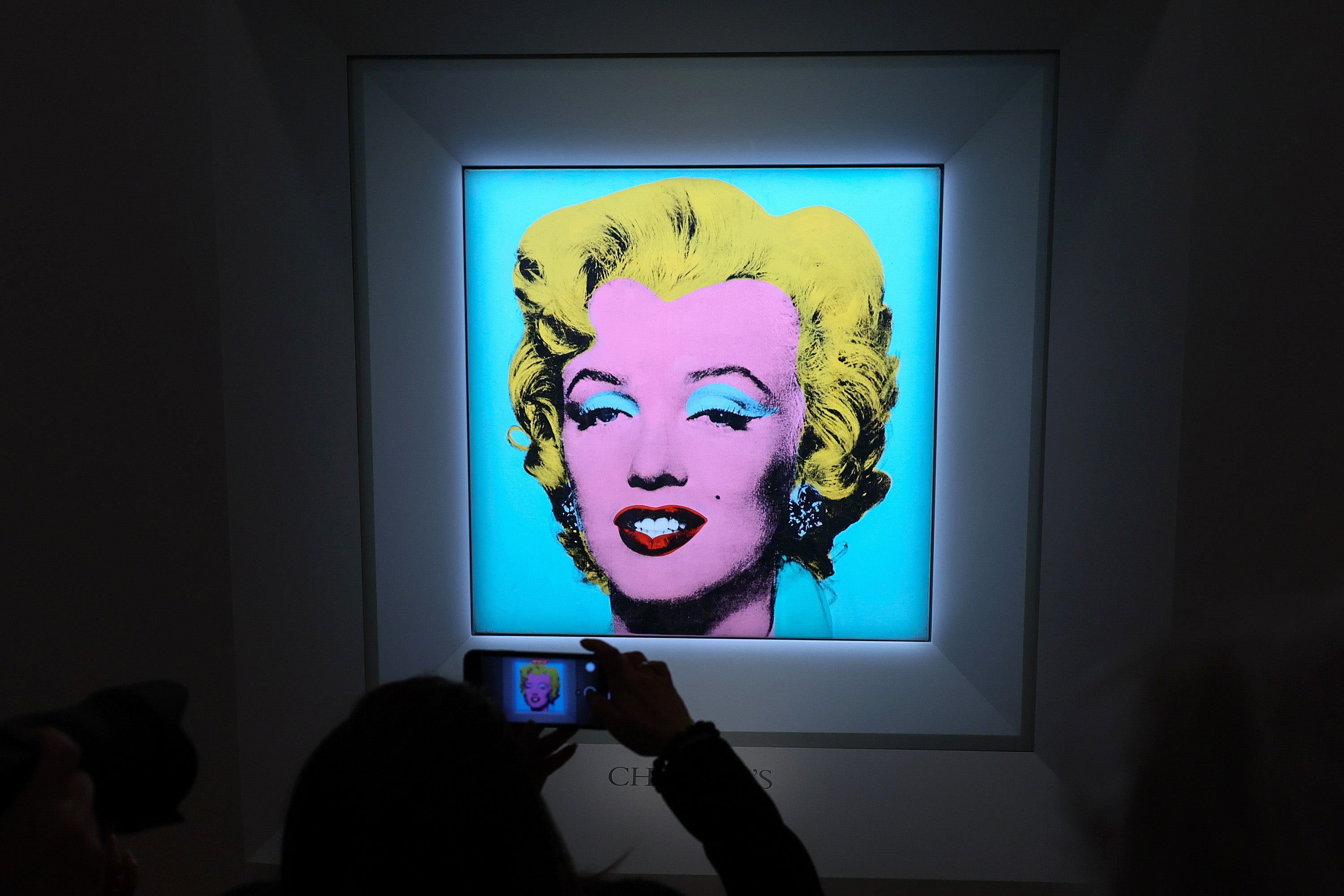The Independent's journalism is supported by our readers. When you purchase through links on our site, we may earn commission.
Andy Warhol, Marilyn Monroe and the darker side of the Sixties
Nearly 60 years after they were first created, Warhol’s portraits of the ill-fated Hollywood star continue to fascinate us, writes Harriet Fletcher

If you remember the 60s, you weren’t really there.” This famous quip says much about our rose-tinted nostalgia for the decade. The fun-loving hedonism of Woodstock and Beatlemania may be etched into our cultural memory, but Andy Warhol’s Marilyn Monroe portraits reveal a darker side to the Swinging Sixties that turns our nostalgia on its head.
Warhol’s iconic portrait Shot Sage Blue Marilyn, which is due to go on sale at Christie’s in May, is expected to fetch record-breaking bids of $200m (£153m), making it the most expensive 20th-century artwork ever auctioned. Nearly 60 years after they were first created, Warhol’s portraits of the ill-fated Hollywood star continue to fascinate us.
According to Alex Rotter, Christie’s chair for 20th and 21st-century art, Warhol’s Marilyn is “the absolute pinnacle of American Pop and the promise of the American dream, encapsulating optimism, fragility, celebrity and iconography all at once”.
Hollywood stars were great sources of inspiration for the Pop Art movement. Monroe was a recurring motif, not only in the works of Warhol but in those of his contemporaries, including James Rosenquist’s Marilyn Monroe, I and Pauline Boty’s Colour Her Gone and The Only Blonde in the World.
Mourning Marilyn
Born Norma Jeane Mortenson but renamed Marilyn Monroe by 20th Century Fox, the actor went on to become one of the most illustrious stars in Hollywood history, famed for her roles in classic films such as Gentlemen Prefer Blondes and Some Like It Hot. She epitomised the glitzy world of consumerism and celebrity that Pop artists thought was emblematic of 1950s and 1960s American culture.
While Rotter’s statement may be true to some extent, there is also a sinister edge to the “Marilyns”, because many were produced in the months following her unexpected death in 1962.

On the surface, the works may look like a tribute to a much-loved icon, but themes of death, decay and even violence lurk within these canvases. Clues can often be found in the production techniques. One of the collection’s most famous pieces, Marilyn Diptych, uses flaws from the silkscreen process to create the effect of a decaying portrait. Warhol’s The Shot Marilyns consists of four canvases, each shot through the forehead with a single bullet. In this, the creation of Warhol’s art is as important as the artwork itself.
Death and Disaster
At a glance, the surface-level glamour of Warhol’s Marilyn immortalises the actress as a blonde bombshell of Hollywood’s bygone era. It is easy to forget the tragedy behind the image, yet part of our enduring fascination with Monroe is her tragedy.
Her mental health struggles, her tempestuous personal life, and the mystery surrounding her death have been well documented in countless biographies, films and television shows, including Netflix’s documentary The Mystery of Marilyn Monroe: The Unheard Tapes and upcoming biopic Blonde. She epitomises the familiar narrative of the tragic icon that is doomed to keep repeating itself – something Warhol understood all too well after surviving a shooting by Valerie Solanas in 1968.
The death at the heart of Warhol’s Marilyns is not just rooted in grief but is also a reflection of the wider cultural landscape. The 1960s were a remarkably dark period in 20th-century American history. A brief look at the context in which Warhol was producing these images reveals a decade plagued by a series of traumatic events.

Life magazine published violent photographs of the Vietnam war. Television broadcasts exposed shocking police brutality during civil rights marches. America was shaken by the assassinations of John F Kennedy, Robert Kennedy, and Martin Luther King Jr. Footage of JFK’s death captured by bystander Abraham Zapruder was repeatedly broadcast on television. Celebrated Hollywood stars were dying young and in tragic circumstances, from Monroe and Judy Garland to Jayne Mansfield and Sharon Tate.
This image of the 1960s is echoed by the postmodern theorist Fredric Jameson, who describes the decade as a “virtual nightmare” and a “historical and countercultural bad trip”. Stars like Monroe were not as flawless as they may appear in Warhol’s portraits, but were “notorious cases of burnout and self-destruction”.
Warhol understood this more than anyone. His Death and Disaster series explores the spectacle of death in America, and affirms the 1960s as a time of anxiety, terror and crisis. The series consists of a vast collection of silkscreened photographs of real-life disasters, including car crashes, suicides and executions, taken from newspapers and police archives. Famous deaths are also a central theme of the series, including portraits of Monroe, Elizabeth Taylor and Jackie Kennedy – all of whom are associated with significant deaths or near-death experiences.
Death and Disaster came about in 1962 when Warhol’s collaborator Henry Geldzahler suggested that the artist should stop producing works that offered an “affirmation of life” and instead explore the dark side of American culture: “Maybe everything isn’t always so fabulous in America. It’s time for some death. This is what’s really happening.”
He handed Warhol a copy of the New York Daily News, which led to the first disaster painting, 129 Die in Jet!.
The recent hype around the auctioning of the Marilyn portrait reveals as much about our time as it does about our nostalgia for the 1960s. We choose to remember the decade in all its glorious colours, but uncovering its darker moments provides room for reconsideration. Perhaps Warhol’s Marilyn is not just a symbol of the Swinging Sixties, but an artefact from a time that was as turbulent and uncertain as our own.
Harriet Fletcher is an associate lecturer in English and History at Lancaster University. This article first appeared on The Conversation
Join our commenting forum
Join thought-provoking conversations, follow other Independent readers and see their replies
Comments



Bookmark popover
Removed from bookmarks